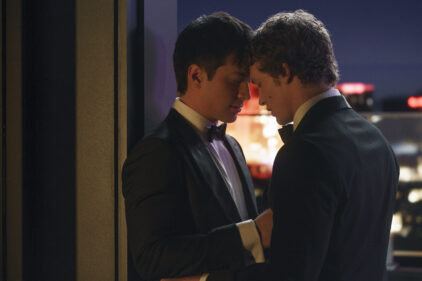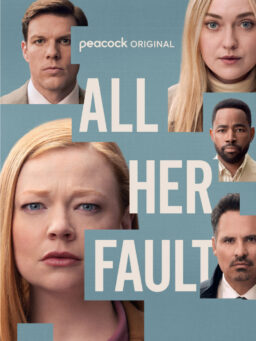<span class="s1" There’s an electric moment relatively early in “Fosse/Verdon” in which Gwen Verdon somehow knows the steps to a dance seconds before she learns them. It’s an interaction that gives the impression of a meteor hurtling towards the earth—an unstoppable, world-changing event. It’s no mistake that the points of comparison used in the preceding sentence are all disastrous in some way; while that dance would lead to a loving relationship and incredibly fruitful artistic partnership spanning decades, it also blew up some lives in the process. Yet the feeling it instills is not one of dread, but of simply revealing the natural order of things. It’s like a nature documentary. Birds flock in unison, somehow tethered together, and Bob Fosse and Gwen Verdon dance with four feet and one mind.
<span class="s1" This compelling, simple moment pops up in the second episode of “Fosse/Verdon,” the new FX series from writer Steven Levenson (“Dear Evan Hansen”), director Thomas Kail (“Hamilton”), and fellow executive producers Lin-Manuel Miranda, Sam Rockwell, Michelle Williams, and Joel Fields (“The Americans”). The person who created that dance and the person dancing would soon become husband and wife, but to call this meeting “love at first sight” is to bypass what makes it special. It pinpoints to the second the thunderclap of a realization shared between two people that they are in possession of a secret language all their own. But it shares a sense of inevitability, like watching a car crash in slow motion, with that earlier, considerably warmer and sexier sequence. It’s Verdon (Williams), overflowing with love and optimism, arriving at a Berlin hotel room door, behind which is Fosse (Rockwell), who’s about to break her heart.

Those two scenes lay plain the two relationships, contained within one, which are the heart of “Fosse/Verdon.” When this limited series focuses on that relationship, it’s gripping, not least because Rockwell and Williams are remarkable performers doing unsurprisingly great work (Williams in particular is exemplary). And the series does, for the most part, keep its focus there, teasing out the messiness and conflict in the bond between two artists who bring out the best in each other—and in the case of Verdon, an artist whose significant behind-the-scenes contributions to Fosse’s body of work have been largely overlooked or undervalued. It’s also another story of a “troubled genius,” though refreshingly, “Fosse/Verdon” extends plenty of compassion to Bob Fosse without romanticizing either his trauma or his damaging behavior, and nearly as novelly, paints a portrait of Verdon that’s neither the saintly, long-suffering wife, nor the jealous, resentful shrew. She’s a human being, as is he, both creatures of complexity who managed to love each other, wound each other, and create great art all at once.
But “Fosse/Verdon” has a lot more on its mind than character study. In the five episodes provided to critics for review (three directed by Kail, one each by Adam Bernstein and Jessica Yu), the series takes a lot of swings. Stylistically, it borrows from Fosse the director at times, embracing the rhythmic, sometimes psychologically-driven editing of “Cabaret” and “All That Jazz” and the use of musical numbers as juxtaposition for what’s happening elsewhere in the story (sometimes even without the music, as when Verdon transports the gorilla head destined for “If You Could See Her” from “Cabaret” from New York to Germany in an act of pure love for a man others would tell her isn’t worthy of such affection and loyalty). It also recreates moments from films and stage musicals with a level of almost feverish detail. It sometimes make a point soundly, then builds to another chance to make that same point for the rest of the episode. And on top of that, it plays fast and loose with time, using even the title cards intended to root the audience in the correct time and place to place yet another narrative lens on the story, and that lens changes with some frequency as well: days ‘til death, days ‘til opening, days since an award win, number of awards won, and on, and on. It’s never simply “1973,” there’s always something more.

It’s a lot. Fittingly, it’s what a song from “Chicago” calls “the old razzle-dazzle,” a term used by a lawyer to encourage his very guilty client to show off her legs, put on the years, and give the jury a show. The problem is, “Fosse/Verdon” doesn’t need the razzle-dazzle, or at least, not this much. One captivating sequence early on sees Verdon melting a crayon to use as clumpy mascara on the lashes of one of the dancers in “Cabaret”; in it, she pieces together the story of the character this dancer is playing, wondering what and why she’s hiding behind all her caked-on makeup, what she wants to conceal. This series, too, lays it on thick, and it’s hard to understand why. That’s not to say the series shouldn’t take these big swings—Kail, in particular, is a gifted director, and nearly all the stuff he tries (and there’s a lot of it) works on some level. But it’s so much, and for so long, and none of it, not the period-accurate cameras, not the chaotic flashes of Fosse’s childhood tap lessons or upsetting glimpses of Verdon’s young life, not the admittedly excellent Liza Minelli impression (Broadway stalwart Kelli Barrett) nor the eye-popping costume parade (Joseph La Corte) is anywhere as captivating as the sight of those two actors talking, screaming, watching, and especially, dancing.
Any quibbles one might have with this season fly away when the dancing begins—and that’s true of nearly all of it, not just the sequences in which Williams and Rockwell impressively hoof it. That’s fitting. Dance is a language of the body, a way of telling stories, of, as Fosse puts it in that excellent second episode, taking your inner torment and transforming it into something beautiful and entertaining. It’s the language that first connects Fosse and Verdon, and it’s the language that this series speaks best. The chaos can threaten to overwhelm the whole. Yet, like Fosse’s choreography (here often recreated in full, thanks to the involvement of co-executive producer Nicole Fosse), the moments of isolation prove irresistible, and the sequences of bodies in perfect unison are even harder to shake.
Five episodes screened for review.












